On going Research Project:-
1. “An improved seed drill choke indicator”sponsored by Department of Science Technology Ministry of Science Technology Govt. of India, New Delhi
Dr A.K. Rai, Head ID & SC (Principal Investigator) Jawaharlal Nehru Krishi Vishwa
Vidyalaya Jabalpur (MP)
The seed cum fertilizer drill is a tractor driven implement for the purpose of sowing
seeds and application of fertilizers in the field. It drops the seed and fertilizers
at specified rate with preset arrangement for placement. The main problems with
most of the presently available seed cum fertilizer drills are that they get intermittent
obstruction in sowing and fertilizer applications due to the blockage of channels
through which process takes place.
The innovated device eliminates the above said problems by online monitoring of
seeding activity and removal of choking channels whenever it occurs. The improved
seed cum fertilizer drill choke indicator will be an attachment to the seed cum
fertilizer drill available in the market. This innovation enhances the accuracy
of seeding and fertilizer placement of the classical seed cum fertilizer drill.
The implement consists of two parts viz. the Electronic and the Mechanical part.
The electronic part senses and indicates the choking in the seed channels and then
sends audio and visual signals to the driver. After knowing that the choking has
happened, driver can initiate the mechanical part to remove the choking. Some salient
utilities of innovative system are listed below
- Optoelectronics sensor is used for detecting the choking instantaneously.
- Photo transistor near IR has been selected as a source. This avoids errors due to
stray visible light.
- Sensors are mounted just above the furrow opener to detect the choking immediately.
- Sensors are encased in such a way the atmospheric condition like dust, rain do not
affect the performance of implemented system.
- Provisions are made for of audio-visual indication, whenever, choking occurred.
- The indicator panel consists of several red LEDs corresponds to respective channels
and yellow LEDs to indicate the status of seed and fertilizer boxes.
- For each seed and fertilizer channel separate sensor are used.
- It becomes more relevant at night time sowing when choking recognition is very difficult
by human eye.
- To avoid an additional manpower for monitoring the seed operation.
- Flat iron finger is used to remove the choking from the furrow opener.
- The developed mechanism designed in such a way that driver can initiate the motion
of flat iron finger (back and forth oscillating motion) generated on the principal
of crank-rocker four bar mechanism.
- For maintaining uniform distribution of seed in the field resulting healthy growth
of the crops.
- The whole implement is compact, economical, durable, efficient and easy to maintain.
Completed Projects:-
1. "Data base generation and evaluation of production technology of medicinal and aromatic plant using IT tools – Funded by MPcost, bhopal.
Objective of the Project:- Medicinal and Aromatic plants are the
source for the manufacturing of ayurvedic medicine, active ingredients for some
other types of therapies, perfumes, flavors and cosmetics in the world. India possesses
rich and diverse source of Medicinal and Aromatic plants for fulfilling the demand
of pharmaceutical and cosmetic industry based on these plants at national level
and to some extent at globe level. Medicinal and Aromatic plants are grown in forest
whereas some species can also be grown at farmer’s field by cultivation. Cultivation
in central India is possible because wide variation in soil and climate in the region.
- The objective is to design and develop web based bilingual multimedia software package
for providing information to farmers, growers, Industry and Ayurvedic practitioners.
- To place comprehensive information of sustainable medicinal & aromatic plants
productions are useful to farmers and agriculturists on the website preferably on
www.jnkvv-aromedicinalplants.in
Software Tools
Web Developing Languages :- PHP & MySQL
Designing & Development Tools :- Macromedia Dreamweaver, MS Office, Flash, Adobe Photoshop, Corel Draw, Photo Studio, Micro Office Picture Manager, MS Paint etc.
System plan of the software:- The system plan of the software has been designed and shown to the physiologist, herbal experts and plant protection experts. The suggestions made by them in respect of different modules have been incorporated and the design has been optimized. Database development.
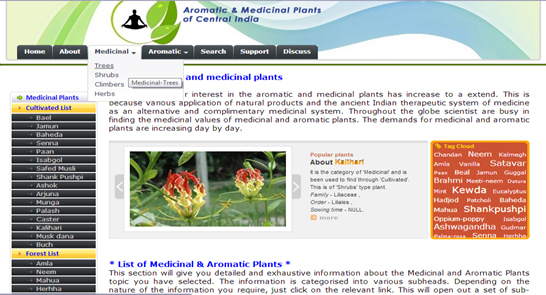
2. Web based information system on production technologies with marketing strategies
along with genetic resource database with characteristics of cultivars of vegetable
crops of central India" sponsored by Ministry of Communication , Information
& Technology, New Delhi.
Objective of the Project: Vegetable being a rich and cheap source
of vitamins and minerals, occupy an important place in the food of Indian consumers.
The country is producing about 98 million tonnes (MT) of vegetables from an area
of around 6.07 million ha. At present there is a lack of sufficient focus and farmers
confront a number of problems. If information pertaining to different aspect of
vegetable production is provided in user friendly way, it will have a great importance
in the present scenario of globalization as it aims to provide appropriate advice
in vegetable production to the farmers.
- To place comprehensive information of sustainable vegetable production and marketing
strategies useful to farmers and agriculturists on the website preferably on www.jnkvv.nic.in.
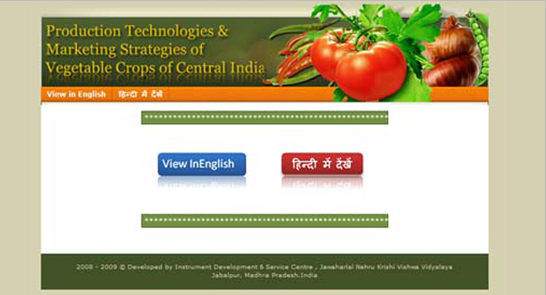
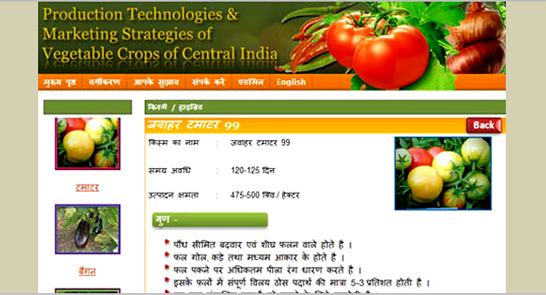
Vegetable Production Technology:
Diverse soil and climatic conditions prevailing in different parts of the country
offer scope for cultivation of a variety of crops in India. The major aspects of
crop production of selected vegetables taken in the system are:
- Variety/Hybrids
- Climate and Soil
- Field Preparation
- Nursery Management
- Intercultural, Weed and Irrigation Management
- Nutrient Management
- Insect Management
- Disease Management
- Intercropping
- Marketing Information
- Harvest and Post Harvest
Web Development
Dynamic pages are designed using php, Javascript, AJAX as front end. The back end
(database) is created using MySQL.
3. E-agrotech
E-agrotech software is prepared for disseminating production techniques of various
crops by use of information technology. The project is sponsored by Ministry of
Information Technology, New Delhi and Govt. of Madhya Pradesh. The Software is bi-lingual
and is developed for farmers, scientists, teachers and KVKs. No special training
is required know the contents of the software.
The software contains information about almost every aspects of crop production
technologies. Some aspects like quantity of chemical fertilisers and time of sowing
is based on crop production techniques of MP. For other regions, these aspects can
be modified according to their agroclimatic zones. The software package contains
different modules like kharif, rabi, diagnosis, cropping system, fruit crop and
resources available.
- Kharif: In Kharif module, production technologies of paddy, soybean, maize, groundnut,
sesamum, pigeon peas, sunflower, moong, urd, kodo, kutki, cotton and sorghum are
given.
- Rabi: In Rabi module, production technologies of wheat, chickpea, mustard, sunflower,
safflower and maize are given.
- Fruit crop: In fruit crop, production technologies and management aspects like propagation,
orchard plan, after care, nutrition, irrigation, disease and insect control, variety
and harvesting are given.
- Diagnosis module, questions based on crop growth and establishment, insect, disease
and weed problems are given and accordingly necessary recommendations are suggested
by the software.
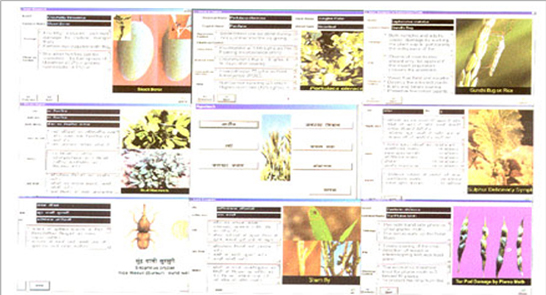
4. e- IPM
e- IPM is developed in visual basic 6.0 as front end and MS
access 2000 as backend. It is multimedia bilingual (English/Hindi) software developed
for pest, disease, nematode, weeds, and nutrient disorder management of major oilseed
and pulse crops of central India. In the e-ipm, each crop module is separate and
includes information pertaining to integrated pest management of the selected crop.
The e-ipm incorporates information on natural enemies, resistant varieties, agronomic
practices and ipm modules of each crop. E-IPM is user friendly software and a person
having simple basic knowledge of computer can browse the contents of the software.
It has multimedia effects like audio, still photos with zooming effects, movies,
and life cycle diagrams. It includes a user interactive diagnosis module for pest
and disease problem and a search module with different searching options using common
name or scientific name for pest management. Apart from all these, it is a resource
of information regarding seeds, fertilizers, bio-pesticides centers, storage and
technical enquiry.
The software is having mechanism for updating and incorporating new technologies
as and when needed. Efforts have been made to cover most of the aspects of integrated
pest management of groundnut, cotton, soybean, sunflower, safflower, mustard, sesamum,
Niger, chickpea, moong, urd and pigeon pea. The information given are reviewed and
edited by plant protection experts.

5. FERTEC
FERTEC is a fertiliser recommendation package. This is a decision
aid package for recommendation of fertilisers based on soil-test values of major
nutrients -Nitrogen, Phosphorus, Potassium (N, P, K) -present in a cultivator's
field. The package has been developed at the UNDP-DoE- Microprocessor Application
Engineering Programme, JNKVV Jabalpur Centre. It is designed using the empirical
relationship, formulated by the All India Coordinated Research Project on Soil-Test
Crop Response Correlation of Indian Council of Agricultural Research, based on the
field experiments conducted by the project's centre with Dept. of Soil Science &
AgricuItural Chemistry, JNKVV, Jabalpur for various crops cultivated in different
agroclimatic regions of Madhya Pradesh.
Technologies Developed
Multichannel Electronic Choke Indicator System for tractor Driven Seed Drills
(Patent Number-232368)

Patent has been granted for the developed invention entitled “A
sensing device for use with a tractor” for the term of 20 years from 25th March
1997 in accordance with the provision of the patent Act 1970. Application No 746/DEL/1997.
Date of filing 25/3/1997. Patent filed through the funding agency i.e. Secretary,
Department of Electronics, Govt of India. Date of Grant 16.3.2009. Patent No 232368
.
Inventors- A K Rai, K. Sivadasan & S.N. Murty
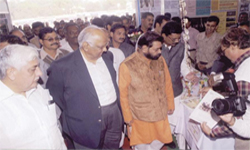
Seed drills are extensively used with tractor for sowing seeds in Agricultural fields.
Modern seed drills are famous for its proper sed rate, uniform distribution and
correct placement of seeds in soil, while sowing nine channels seed drills are generally
manufactured in the country and are being used. Seed pass through the seed tubes
of the seed drills before dropping into furrows in fields. Due to excess moisture
in soil or some other reason the seed tubes often get choked/blocked while sowing.
To detect such choking a labourer is to be employed simply for monitoring the seeding
operation. But due to human error often he fails to detect the choking immediately,
resulting omission of seeding in certain rows in fields. This causes non uniform
distribution and also reduces the yield. The above problem is more serious when
sowing is done in night times.
Keeping the above in view, ALFA Centre has developed a Multichannel Electronic Choke
Indicator which monitors seed dropping through seed drills and gives audio/visual
indications to the tractor driver whenever seed tube(s) get(s) choked and /or seed
box becomes empty.
Main features of the developed system : .During normal sowing condition, green LED
of the Status Indication Panel glows. While sowing, anyone or more seed tubes of
the seed drills, if get choked, corresponding red LED(s) of that channel(s) glow(s)
together with audio alarm.The status of the seed box is also monitored by the system.
During sowing when seed box becomes empty, the system indicates this status by glowing
a yellow LED Channels (expandable) along with audio alarm. The system can be made
operational using Power Supply: Through tractor the tractor battery or a separate
rechargeable battery or 6V 6 volt battery. Since the status indication panel of
the rechargeaole system is small in size, it can be fitted near battery the seat
of the tractor driver, so that he can take corrective measures according to the
audio-visual indication The developed system will help farmers to carry out sowing
in a proper way for obtaining better yield. The system has undergone extensive field
trials and found working satisfactorily.
Microcontroller Based Rice Polish Measurement
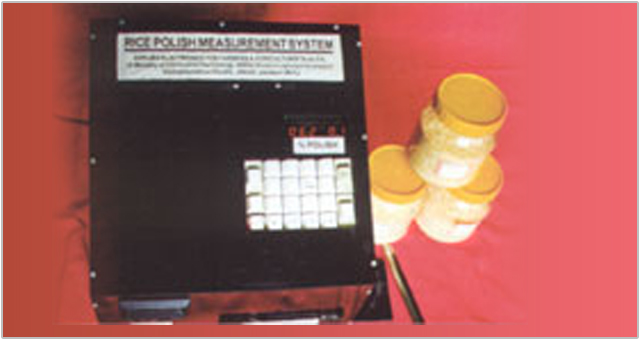
The operation of removing bran layer from brown rice is known as polishing. This
operation is very critical and the milling quality and quantity of rice depends
on polishing process. The polishing operation in rice milling is important in terms
of obtaining optimum polish percentage, avoiding breakage losses and consumption
of energy. By quantitatively measuring the polish level one can enhance the quality
of rice during polishing operation.
The rice polish measurement system is microcontroller based and gives the readings
directly in terms of polish percentage of rice samples for the calibrated varieties.
The principle of operation is by measuring the reflected levels of electromagnetic
radiation from rice samples. Reflected radiation has two components, diffuse and
specular. In the system, diffuse radiation from the rice sample is measured. A narrow
band of monochromatic radiation is directed on the rice sample. The sample absorbs
some of the radiation, the rest is reflected. More polish on the rice sample, less
the amount of absorbance and more radiation is reflected from the sample. The reflected
radiation from the rice sample is the measure of level of polish in the sample.
Fertilizer Testing Kit
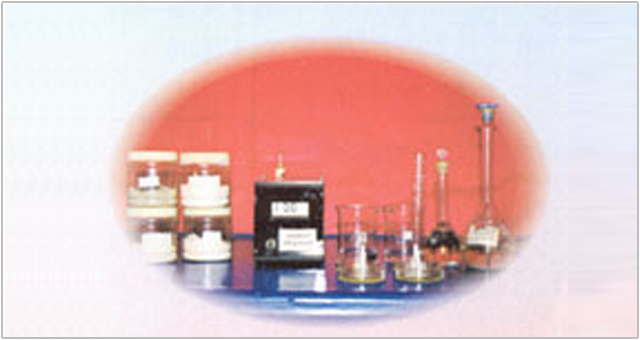
Increasing demand of chemical fertilizers with escalating cost is leading to the
sell of sub- standard fertilizers in some regions of the country. The quality of
fertilizers are of utmost important to obtain optimum yield of any crop. At present,
there is no simple instrument and technique for accessing the quality offer fertilizers
at village/user level. The fertilizer testing kit developed by the ALFA Centre can
be used for determining approximate percentage of adulteration in chemical fertilizers
(phosphatic fertilizers and urea).
System Description
The system consists of few chemicals, limited glassware and a photometer The photometer
is having optical head unit, sample holder, signal conditioning circuitry and digital
display. Photometric method hasbeen used fordetermining the level of adulteration.
In the photometer, monochromatic radiation is obtained from blue light emitting
diode. This radiation is allowed to pass through the prepared sample resulting in
absorption of the radiation in proportion to concentration of the sample.
Soil Moisture Indication system
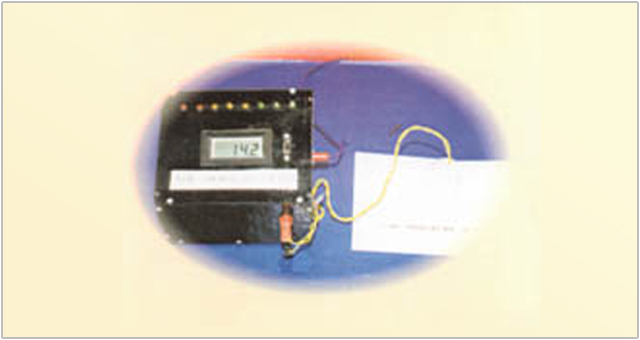
Generally farmers are not using any soil moisture device for irrigation scheduling.
It is mainly due to non availability of suitable soil moisture measurement system
for farmers use. Keeping this in view a low cost easily operateable Soil Moisture
Indication System is designed and prototype fabricated. The system consists of panel
of light emitting diodes i.e. green yellow and red. Gypsum block is used as soil
moisture sensing device. For using the system, number of sensors (depending upon
the size of a field) have to be implanted at a particular depth i.e. near the root
zone of the crop. By connecting sensor terminals to this instrument., status of
soil can be found.
Soil Nutrient Estimation system
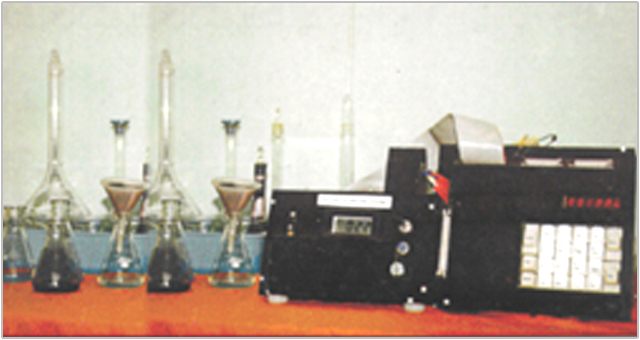
Soil-testing is a well recognised practice for the determination of factors like
plant available N,P,K,S (Nitrogen, PhosphoruS,Potash and Sulphur), certain micro-nutrients,
and other parameters. Soil-test values are used for Ule formulation of fertiliser
recommendations. The available nutrient contents in the soil is categorized in different
bands and these bands are designated as VL, L, M, H and VH (i.e. Very Low, Low,
Medium, High and Very High nutrient levels). Each band is a concentration band between
two values of the nutrient contents. Band level measurements are being used in soil
testing for recommending fertilizer doses to the farmers.
System Description
The system facilitates the determination of organic carbon (indirect nitrogen),
available phosphorous and sulphate in soil. Photometric methods are adopted for
quantitative analysis. The system has some novel features as:
Differential mode of analysis
- Opto-electronic working
- Results obtained are directly usable for fertiliser recommendation
- Optional attachment, microcontroller based read-out for knowing the available nutrients
levels in ppm and kg/ha. Nutrient band level calibrations are also provided for
available phosphorous
- Two light emitting diodes (Red & Blue) have been used as an excitation sources
for obtaining mono-chromatic radiation and photo-transistors are used as detectors.
A user can opt quantitative analysis of I Organic Carbon, Phosphorus or Sulphur
by pressing N, P and S keys followed by pressing RUN key. After calibration, the
readings can be obtained in kg/ha or ppm values as per option selected
Microprocessor Based Grain Moisture Measurement System
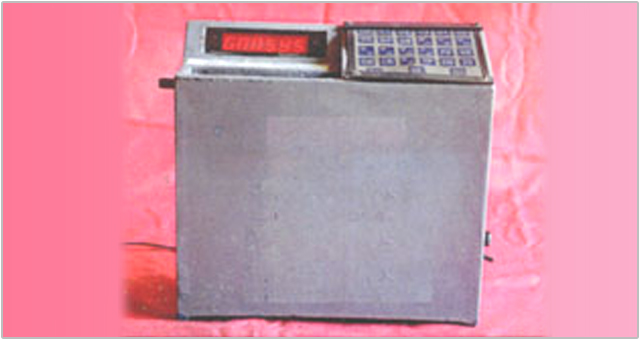
The quality of grains is influenced by its moisture content. Moisture content of
food grains/seeds is required to be measured due to various reasons, such as to
know the status of moisture in grains/seeds before storage, to know optimum stage
of harvesting of a crop, to price the agricultural products in mundi and for, R&D
purposes.
The system works on the capacitance measurement principle. The grain sample of fixed
quantity is to be poured inside the grain chamber for the measurement of grain moisture.
Grain acts as a dielectric medium. Temperature sensor (thermistor) embedded inside
grain chamber senses grain temperature and incorporates temperature compensation
in the measurement. The system is calibrated for wheat, paddy & soybean. However,
a user can calibrate the system at his level for other grains also (detailed calibration
procedure to be adopted for the purpose will be supplied). The quantity of the sample
required for measurement is around 500 gm (varies with commodity).
Grain Moisture Meter
Grajn moisture meter is a portable instrument which is handy, light weight, and
easy in operation. The moisture meter is designed to provide ease of operation combined
with a calibration chart corresponding to the reading of the moisture
meter (presently calibration of wheat comn1odity is completed). The moisture can
be read out on 3. digit LCD display. Grain/seed sample of 450-500 gm is filled in
the grain cell upto a particular level. Measurement of grain moisture for each sample
takes about 30 seconds. It is a non-destructive measurement without affecting the
sample. There is no need to weigh the grain sample.